An outbreak of severe hepatitis in children has continued to grow, with new cases now identified in the U.S., the World Health Organization (WHO) reported this weekend.
The WHO published its first report on the outbreak on April 15, when cases were isolated in the United Kingdom. At the time of that report, there were a total of 10 cases in children between the ages of 11 months and 5 years old.
No cause has been identified as of yet. As of last week at least 169 cases of acute hepatitis, or liver inflammation, of unknown origin had been reported in children between the ages of 1 month and 16 years old. While still concentrated in the U.K., additional cases have appeared in Spain, Israel, the U.S., Denmark, Ireland, the Netherlands, Italy, Norway, France, Romania, and Belgium. At least one death has been reported, according to the WHO.
The common viruses associated with acute viral hepatitis—hepatitis A, B, C, D, and E—have not been identified in any case. Adenovirus, a class of common viruses that typically cause self-limiting infections in humans, has been identified in at least 74 cases, according to the report. The WHO is also investigating connections between the outbreak and COVID, which was identified in 20 cases.
At least one child has died after falling ill from a mysterious outbreak of acute hepatitis that has infected children in 10 .
“Cases are aged 1 month to 16 years old. 17 children (approximately 10 per cent) have required liver transplantation; at least one death has been reported,” the WHO said on Saturday.
Hepatitis is inflammation of the liver, which is a vital organ for processing nutrients, filtering blood, and fighting infections.
While the WHO said that the cause of the infections was still being investigated, the UN body noted that an adenovirus infection leading to acute hepatitis was one possible option under consideration.
“The common viruses that cause acute viral hepatitis (hepatitis viruses A, B, C, D, and E) have not been detected in any of these cases,” the WHO said in a statement, adding that adenovirus had been detected “in at least 74 cases”.
Where have cases been detected?
As of April 21, 114 cases had been reported in the United Kingdom, 13 in Spain, 12 in Israel, nine in the United States, six in Denmark, fewer than five in Ireland, 4 each in the Netherlands and Italy, 2 in Norway and France and 1 each in Romania and Belgium, the WHO said.
Beyond acute hepatitis and elevated levels of liver enzymes, symptoms in the reported cases have included abdominal pain, diarrhea, vomiting, and jaundice. Adenoviruses, which typically spread from person to person, most often cause respiratory symptoms like coughing, sore throat, and runny nose. Depending on the specific type, those affected can also develop gastroenteritis, pinkeye, and bladder infection, among other symptoms.
There are more than 50 adenovirus types that can infect humans, according to the WHO’s report. Of the cases that had access to molecular testing, 18 were identified as involving adenovirus type 41, which has never before been closely linked with severe hepatitis. It most often causes diarrhea and vomiting.
“While there have been case reports of hepatitis in immunocompromised children with adenovirus infection, adenovirus type 41 is not known to be a cause of hepatitis in otherwise healthy children,” said the WHO in its report.
The high incidence of adenovirus infections associated with the hepatitis outbreak could simply be due to better testing, according to the WHO. “While adenovirus is currently one hypothesis as the underlying cause, it does not fully explain the severity of the clinical picture,” said the WHO.
The WHO said that hypotheses relating to side effects of the vaccine are not supported, since most affected children had not been vaccinated. In the U.S. children under 5 are still not approved for the vaccine.
The U.S. Centers for Disease Control and Prevention (CDC) has previously linked COVID with Multisystem Inflammatory Syndrome in Children (MIS-C), a condition characterized by inflammation of different organs. A paper published in the scientific journal Hepatology in late 2020 identified hepatitis as a common symptom in children afflicted with MIS–C.
“Further work is required to identify additional cases, both in currently affected countries and elsewhere,” the WHO said in regard to proper public health response to the hepatitis outbreak. “Common prevention measures for adenovirus and other common infections involve regular hand washing and respiratory hygiene.”
EFFECTIVE MEDICINAL PLANTS IN TREATING HEPATITIS
Medicinal plants and natural products have many applications in the treatment of viral diseases, due to much lower side effects. Different types of hepatitis, especially hepatitis B, are of the viral diseases whose treatment using herbal medicines is currently of great interest due to the limited availability of effective chemical drugs and having numerous side effects. Due to the attention paid to herbal drugs and their importance for the treatment of hepatitis B, we conducted this review to take a look at the evidence regarding the action mechanisms of viruses, antiviral herbal remedies and various herbal anti-hepatitis drugs and their therapeutic mechanism published until 2017. To provide data for conducting this review, the most up-to-date electronic journals including those indexed in the Pubmed, Elsevier, Institute for Scientific Information, Google Scholar and Scientific Information Database databases and various books, has been used. There are several plants for the treatment of viral diseases, including hepatitis B, which prevent or decrease infection via various mechanisms. Medicinal plants counteract viruses by various mechanisms, but most of them including Ganoderma lucidum and Oenanthe javanica inhibit the transcription of hepatitis B virus in hepatocytes. Most of action mechanism of medical plants exert an antiviral effect through inhibiting the transcription of HBV in hepatocytes; the need to study effective medicinal plants for treating different types of hepatitis, including hepatitis B and their action mechanisms have been intensified more than ever before, which makes this subject even more important.
Hepatitis C virus (HCV) is a global health concern which is responsible for most of the liver diseases. Currently, there is no vaccine available for prevention of HCV infection due to the high degree of strain variation. The current standard of care is a combination of pegylated interferon α with ribavirin and boceprevir/telaprevir. This treatment was partially effective and had significant side effects. Hence, there is a need to develop new antiviral agents that interfere with different stages of the HCV life cycle. Recent advances in the understanding of both the cellular and molecular mechanisms of HCV replication have provided the basis for novel therapeutic strategies. Several hundred plant species and their phyto-constituents have been isolated for screening against HCV, and some have been shown to have great medicinal value in preventing and/or ameliorating viral diseases in pre-clinical and clinical trials. This review summarizes medicinal plants and their phytochemicals which inhibit different stages of HCV life cycle and discuss their potential use in HCV therapy.
Being one of the most essential and largest organs in our bodies, there is a need for us to adopt only the healthy habits that will keep our livers healthy at all times. Considering that many people have resorted to several unhealthy habits that could endanger the liver, it is high time such people started making a U-turn!
But peradventure you are oblivious of certain common habits that could damage your liver, it might interest you to know that habits such as; excessive alcohol intake, excessive salt intake, malnutrition, excessive sugar intake, smoking, excessive animal protein intake, low water intake, sleep deprivation, excessive coffee intake, consumption of high cholesterol foods, medication abuse etc can adversely affect the functioning of your liver.
So is any of these damaging habits part of your daily routine? If yes, then I can assure you that there is always a second chance! It is not too late for you to make a total U-turn in other to put back your most valuable organ back on track. Now is a perfect time to count your teeth with your tongue, put your feet on the ground and stick to your positive decision of total U-turn no matter whose OX is gored.
Your health is your most expensive asset so why play hanky panky with it? 😀 Don’t you think it is high time you started paying much attention to every nitty gritty of your health to ensure that all your body organs, which are integral to the healthy functioning of your body are in perfect conditions.
It is worthy to note that adopting those liver damaging habits could easily inflame the liver and cause several uncomfortable symptoms. This can possibly lead to liver diseases such as hepatitis, cirrhosis (liver scarring), liver cancer and death. Khare et al., (2015) define hepatitis as the health condition that is caused by a virus and marked by an inflammation of the liver. The main types of viral hepatitis are hepatitis A, hepatitis B, hepatitis C, hepatitis D hepatitis E, alcoholic hepatitis (excessive alcohol intake), medication abuse, toxins and autoimmune hepatitis (immune system attacks that damage the liver).
Hepatitis A is caused by the Hepatitis A virus (HAV) and is most prevalent in the under-developed and developing countries. This is as a result of the poor sanitation standard in these parts of the world.
Hepatitis B is caused by the hepatitis B virus and is common all over the world. It is usually spread in the blood and can be transmitted from an infected mother to the newborn, through unsafe injections or through unprotected sex.
Hepatitis C is caused by the hepatitis C virus and can be transmitted by blood to blood contact with an infected individual, by sharing needles, through unsafe injections and through poor health-care practices. According to Halegoua-De Marzio and Fenkel (2014), Chronic hepatitis C (CHC) infection affects almost 3% of the world population. Furthermore, HCV can lead to liver failure, cirrhosis and hepatocellular carcinoma. Hepatitis C virus is the leading cause of most of the liver diseases.
According to World Health Organisation (2016), there is currently no available vaccine for preventing HCV infection. This is attributed to the high level of strain variation however, there is an ongoing research in this area. Hepatitis C is most prevalent in the United Kingdom.
Hepatitis D is caused by the hepatitis D virus and can affect only those who have been infected with hepatitis B. This is attributed to the fact that this virus can only survive in the body through the help of the hepatitis B virus. It can be spread through unprotected sexual acts or blood to blood contact. Hepatitis C is prevalent in the Middle East, Africa, South America and Europe. NHS UK (2016) reports that there is no specific vaccine for hepatitis D, however, the hepatitis B vaccine can help to protect an individual from it.
Hepatitis E is caused by the hepatitis E virus and is most prevalent in the United Kingdom. It can be spread through the consumption of food and drinks that are contaminated by faeces of an infected individual. NHS UK (2016) attests that there is no vaccine for hepatitis E, however, one can reduce the infection risk by adopting good food and water hygiene measures especially when travelling to countries with poor sanitation.
Hepatitis can be acute (illness occurs within the first 6 months after exposure to the virus) or it can be chronic (long-term and occurs when the virus remains in someone’s body for a long time). If left untreated, hepatitis can lead to critical liver issues. Some symptoms of hepatitis include; loss of appetite, grey-colored faeces, fever, jaundice (yellowing of the skin or white parts of the eyes), nausea, stomach pain, fatigue, joint pain, feeling sick and dark-coloured urine.
Hepatitis disease has always been a global concern and tackling it at an early stage to avoid death has remained an area of interest. Since there are currently no vaccines for tackling some types of hepatitis, several researchers are driving attention towards unravelling specific medicinal herbs and plants that can act as inhibitory drugs for preventing and suppressing hepatitis infections. Some of these medicinal plants are discussed below;
19 Powerful Medicinal Plants for Treating Hepatitis

Grapefruit
Grapefruit, which is botanically known as Citrus paradisi is a citrus tree distinguished by its sour-sweet fruit. It is originally from Barbados before spreading to other parts of the world. Grapefruit is a cross-breed of shaddock or pomelo or (citrus maxima) and sweet orange (Citrus Sinensis). The tree grows approximately 5 to 6 meters height, the greenish glossy leaves can grow up to 15 centimetres while the fruit measures approximately 10 to 15 centimetres.
Grapefruit tree bears four white petaled flowers. The yellow-orange skinned fruit is distinguished by its sphere-like shape. Grapefruit has varying taste, which is determined by a sulfur-containing terpene known as mercaptan. The fruit is highly acidic in nature and its pulp can be reddish, pinkish or whitish in colour depending on the cultivars. The bitter taste of this fruit is attributed to the presence of naringin flavonoid, which is metabolized into naringenin. Grapefruit is an excellent source of vitamin C, vitamin B1, biotin, pectin, copper, vitamin A, potassium, pantothenic acid, lycopene and dietary fibre. Furthermore, the grapefruit seeds contain antioxidant properties.
Nahmias et al., (2008) demonstrated that the grapefruit flavonoid naringenin inhibits the microsomal triglyceride transfer protein activity. Stimulation with naringenin reduces hepatitis C virus secretion in infected cells by 80%. Furthermore, they found out that naringenin is effective at concentrations that are an order of magnitude below the toxic threshold in primary human hepatocytes and in mice. Their results suggest the effectiveness of grapefruit for treating HCV infection. As a result, the idea of augmenting hepatitis C patients’ diets with naringenin should be encouraged. So if you suffer from hepatitis C, take grapefruit and grapefruit juice regularly to clear the virus.

Dandelion (Taraxacum Officinalis)
Dandelion, which is botanically known as Taraxacum officinale is from the Asteraceae family. It is a perennial herb that grows between 3 to 35 centimetres tall. It is distinguished by its hairless leaves that measure approximately 5 to 30 centimetres long and 1 to 10 centimetres wide. Dandelion is originally from Europe before spreading to other northern temperate regions of the world. Dandelion bears a rosette of leaves at the base while it bears a single, golden-yellow flowers at the apex.
The plain hollow stems usually emerge from the middle of the rosette and each of the flowers bears several florets. Mature florets bear downy seeds that are easily dispersed by the wind. The fleshy brittle roots are dark brown colour externally and white colour internally. Dandelion is an excellent source of vitamin A, vitamin C, vitamin B6, calcium, iron, dietary fibre, potassium, magnesium and protein. In folk medicines, dandelion is considered an effective herb for treating liver disorders. According to Hook (1994), dandelion plants were used by East Indians in the 16 century as a hepatic stimulant, diuretic and for liver disorders.
Al-Malki et al., (2013) evaluated the hepatoprotective effects of dandelion leaves water extract against carbon tetrachloride (CCl4) intoxication in liver albino rats. They used carbon tetrachloride as hepatotoxic agent and the dandelion leaves water extract as a probable hepatoprotective agent. Several biochemical parameters were studied to evaluate the hepatoprotective activity of dandelion leaves water extract.
The results showed that the serum markers in rats treated with CCl4 recorded high concentration and this indicates severe hepatic damage by CCl4. However, the blood samples from dandelion treated animals showed a significant reduction in the serum markers, which indicates that the plant extract was capable of restoring the normal functional ability of the hepatocytes. Therefore, their study showed that dandelion leaf water extract exhibits a significant protection against CCl4 induced hepatocellular injury.

Turmeric
Turmeric is a perennial plant that is botanically known as Curcuma longa and belongs to the ginger family of Zingiberaceae. The plant grows thick rooted rhizomes by which its reproduction takes place. The plant bears 8 to 12 large oblong dark greenish leaves that grow approximately 1 metre long. The yellow-whitish sterile flowers are borne on a spike-like stalk that measures between 10 to 15 centimetres long. The thick rhizomes are the source of the yellow brightly coloured spice that is mostly used for spicing food and for dying.
Some turmeric species include; Curcuma zedoaria (zedoary), Curcuma amada (mango ginger), Curcuma aromatica (wild turmeric and Cochin turmeric) and Curcuma angustifolia (narrow-leaved turmeric and wild arrowroot). The most vital chemical compounds of turmeric are the curcuminoids (curcumin demethoxycurcumin, diferuloylmethane and bisdemethoxycurcumin. Other essential volatile oils present in turmeric are; zingiberene, turmerone and atlantone. Kim et al., (2009) investigated the antiviral properties of Curcuma longa Linn against hepatitis B virus (HBV) replication in liver cells. The aqueous extract of Curcuma longa Linn (CLL) was prepared and used to analyse its antiviral activity against HBV replication in HepG 2.2.15 cells, which contain HBV genomes.
The turmeric extract subdued the secretion of HBsAg from HepG 2.2.15 cells. The turmeric extract also suppressed the production of HBV particles and the level of intracellular HBV RNAs in HepG 2.2.15 cells, which suggests that the extract inhibits HBV replication. Furthermore, these researchers found out that the anti-HBV activity of turmeric extract is mediated by enhancing the cellular accumulation of p53 protein and by transactivating the transcription of p53 gene as well as by increasing the stability of p53 protein.
The CLL extract subdued the transcription of HBx gene by suppressing HBV enhancer I and X promoter through p53 protein. Interestingly, the turmeric extract did not exhibit any cytotoxic effects on the liver cells. Therefore turmeric extract is considered an effective plant for treating liver diseases caused by hepatitis B virus (HBV) infection.

Garden Cress
Garden cress is an annual plant that is botanically known as Lepidium sativum. It is a fast-growing edible herb that is genetically related to mustard and watercress due to its peppery, tangy aroma and flavour. It is also known as pepper grass, cress, pepperwort, poor man’s pepper or garden pepper cress.
This plant can grow up to 60 centimetres height and it bears clusters of flowers that measure 2 millimetres across. Raw garden cress is an excellent source of vitamin A, vitamin C, vitamin K, water, dietary fibre, protein, carbohydrates, manganese, magnesium and potassium. Read more about garden cress here.
Al-Asmaria et al., (2015) investigated the hepatoprotective activity of ethanolic extract of garden cress using hepatotoxic model induced by CCl4. They also assessed the hepatoprotective role of L. sativum seed extract. The results showed that the pretreatment with garden cress seeds extracts, significantly restored the liver damaging marker enzymes, thereby confirming its hepatoprotective potential. The hepatoprotective activity of the garden cress seeds is attributed to its antioxidant and anti-inflammatory properties such as Alpha linoleic acid.

Fenugreek
Fenugreek is botanically known as Trigonella foenum graecum and it belongs to the family of Fabaceae. It is an annual plant that is used for both culinary and medicinal purposes. The leaves comprise of 3 small oblong leaflets while the amber-yellowish fenugreek seeds are cuboid-shaped in appearance. Both the seeds, dry and fresh fenugreek can be used for garnishing, spicing and flavouring food. The distinctive aromatic flavour of fenugreek is attributed to the presence of the sotolon chemical found in this herb. Read more about fenugreek here.
Al-Sultan and El-Bahr (2015) investigated the protective effects of an aqueous extract of fenugreek against carbon tetrachloride (CCl4), induced hepatotoxicity in rats. It was found out that the administration of CCl4 to rats induced elevation of hepatic transaminases, lipid peroxidation and reduction of antioxidant enzymes activities. However, an oral administration of fenugreek aqueous extract alleviated the detrimental effects of CCl4 and rectified all examined biomarkers toward the control values. This suggests that fenugreek is suitable for tackling hepatitis.

Neem
Neem is botanically known as Azadirachta indica and belongs to the mahogany family of Meliaceae. It is equally known as Indian lilac, nim tree or dogonyaro and it thrives mostly in the tropical and semi-tropical parts of the world. Both the fruits and seeds of the neem tree can be distilled to produce neem oil. Neem is an evergreen fast-growing tree that can reach between 15 to 20 metres height. The tree is distinguished by its wide and spreading branches with a dense roundish crown.
The opposite, pinnate leaves measure between 20 to 40 centimetres long, with 20 to 32 dark green leaves that measure between 3 to 8 centimetres long. The white flowers are formed in drooping axillary panicles that are up to 25 centimetres long. The inflorescences bear between 150 to 250 flowers and each flower measures between 5 to 6 millimetres long and 8 to 11 millimetres wide.
The glabrous fruit is olive-like in appearance and measures between 1.4 to 2.8 centimetres by 1 to 1.5 centimetres while the mesocarp measures between 0.3 to 0.5 centimetres thick. The exocarp (fruit skin) is thin while the mesocarp (pulp) is fibrous, bitter-sweet and yellowish-white in colour. The white endocarp of the fruit encloses the elongated seed that has a brown seed coat. Read more about neem here.
Lakshmi et al., (2015) report that Azadirachta indica has medicinal values thus effective for tackling terrible disorders such as hepatitis.
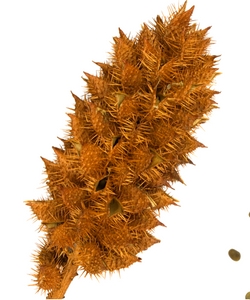
Liquorice (Glycyrrhiza glabra)
Liquorice is a perennial herbaceous plant that is botanically known as Glycyrrhiza glabra. The plant grows approximately 1 to 2 metres height, the foliage leaves measure between 10 to 20 centimetres long, the spike‐like inflorescences measure between 10 to 15 centimetres long while the fruit pod measures between 1.5 to 2.5 centimetres long and 4 to 6 millimetres wide.
Liquorice grows long hardy primary taproot that is approximately 15 centimetres long and divided into 3 to 5 secondary roots. It bears multiple horizontal woody stolons that grow up to 8 metres. The leaflets are between 3 to 8 pairs in number and each of the blue-pale violet flowers measures approximately 1 to 1.5 centimetres long.
According to Lakshmi and Geetha (2011), liquorice contains the glycoside known as glycyrrhizin, which has close similarities with the adrenal steroids. As a result, the natural compound glycyrrhizin that is extracted from the roots of Glycyrrhiza glabra is mostly used for treating chronic hepatitis. Liquorice is considered effective for treating hepatitis due to its anti‐inflammatory effect that is similar to cortisone as well as due to its anti-allergy and anti-viral properties.

Barbados Nut
Barbados nut, which is botanically known as Jatropha curcas Linnaeus is a poisonous plant from the spurge family of Euphorbiaceae. Barbados nut is originally from Central America and Mexico before spreading to other tropical and subtropical parts of the world. Barbados nut is known by other names such as the physic nut, purging nut or JCL.
The tree grows up to 6 metres height and it is highly resistant to harsh weather conditions thus can survive in places with little or no water such as deserts. Barbados nut is monoecious in nature thus both the male and female flowers are produced on the same inflorescence. The green leaves bear 3 to 5 lobes with a spiral phyllotaxis while the seeds are mature once the capsule changes from green to yellowish colour.
Jatropha curcas plant contains curcin, curcasin, stearic acids, arachidic, palmitic and myristic. The seeds contain the poisonous jatrophin or toxalbumin curcin and approximately 20% saturated fatty acids and 80% unsaturated fatty acids. The seeds yield an oil that contains linoleic and oleic acids. Furthermore, the seeds consist of chemical compounds, such as protein, saccharose, galactose, raffinose, fructose, stachyose and glucose.
How to Treat Hepatitis with Jatropha curcas
Punjaji (2012) reports that Jatropha curcas is an effective plant for tackling hepatitis. To treat hepatitis, this researcher recommends using 2 tsp of stem exudates of Jatropha curcas mixed with equal proportion of jaggery. The mixture should be taken with 1 to 2 tsp of honey by the hepatitis patient at least twice a day for approximately 9 to 12 days in other to cure viral hepatitis.
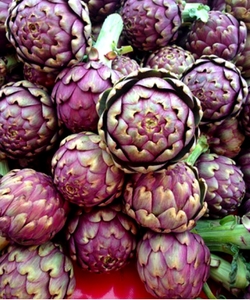
Artichoke (Cynara scolymus)
Artichoke is botanically known as Cynara scolymus and consists of species of thistle cultivated as food. Artichoke is originally from Europe and Australia before spreading to other parts of the world. The budding artichoke flower forms a cluster of several budding small flowers known as the inflorescence together with several bracts. The artichoke stalk emerges from an edible base. Artichoke grows between 1.4 to 2 metres height while the green leaves grow between 50 to 82 centimetres long.
The flowers emerge from an edible bulky bud that measures between 8 to 15 centimetres in diameter with multiple triangular scales. Each of the florets is purplish in colour. The edible parts of the buds are the fleshy lower parts of the clustered bracts and the base, which is known as the heart. The clustered immature florets formed at the centre of the bud is known as the beard or the choke. Artichoke herb is used for preparing herbal medicines for treating liver disorders. The leaf is an excellent source of cynarin and phenolic acids such as inulin, sesquiterpene, vitamins, lactones, enzymes, flavonoids and minerals.
Hamza et al., (2012) found out that artichoke is an effective dietary supplement that contains phenolic compounds needed for preventing oxidative stress-induced hepatotoxicity.

Chamomile (Matricaria recutita)
Chamomile is botanically known as Matricaria chamomilla and belongs to the family of Asteraceae. It is commonly known as scented mayweed, Italian camomilla, camomile, wild chamomile, Hungarian chamomile (kamilla) or German chamomile. Chamomile is an annual plant with a branched, erect and smooth stem. It grows between 15 to 60 centimetres height. Chamomile flowers have a powerful, aromatic smell and they grow on the paniculate flower heads known as the capitula.
The plant can be grown by seeds dispersion, direct sowing of the seed or by transplanting. An active ingredient of camomile essential oil is the terpene bisabolol however, it contains other active ingredients such as coumarin, chamazulene, farnesene and flavonoids (luteolin, quercetin, apigenin and patuletin).
Mannaa et al., (2015) investigated the protective effect of chamomile flowers (CFME) and fennel seeds methanolic (FSME) extracts on azathioprine (AZA), which is an immunosuppressant drug that induced liver injury and oxidative stress in rats. The results revealed that CFME and FSME exhibit hepatoprotective effects against AZA-induced liver injury and oxidative stress. These extracts were able to restore the biochemical parameters as well as improved the histological picture of the liver.
Based on their findings, it can be deduced that chamomile flowers (CFME) and fennel seeds methanolic (FSME) possess hepatoprotective properties against azathioprine. This is attributed to their antioxidant properties and radical scavenging potentials.

Common Fig
Common Fig is botanically known as Ficus carica and it belongs to the mulberry family. Fig is originally from the Middle East and the Asian continent and is believed to be one of the oldest fruit trees recorded in the Holy Bible. Fig is a deciduous tree that grows between 7 to 10 metres tall while the fragrant leaves grow between 12 to 25 centimetres long and 10 to 18 centimetres wide. The fig fruit measures between 3 to 5 centimetres long.
The inflorescence contains syconium, which is a hollow fleshy structure that is lined with several unisexual flowers. The flowers are invisible from outside the syconium, because they blossom inside the infructescence. The edible fig fruit bears the mature syconium that comprises of several one-seeded fruits known as the druplets. Fig fruit is greenish in colour however, it turns to purple-brown once ripen. Common fig is an excellent source of vitamin C, dietary fibre, manganese, potassium, carbohydrate and iron.
Joseph and Raj (2011) report that figs are astringent and carminative in nature thus the dried figs can be given at a dosage of 150 gram with honey to hepatitis patients.
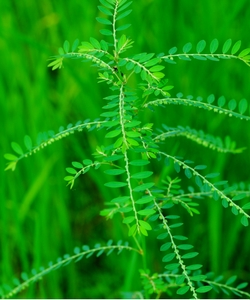
Chanca Piedra
Chanca Piedra is botanically known as Phyllanthus niruri or Phyllantus amarus and belongs to the Phyllanthus genus of the family of Phyllanthaceae. Phyllanthus niruri is an annual plant that is most prevalent in the coastal regions of the world. Chanca Piedra is known by other names such as; seed under leaf, gale of the wind, bhumyamalaki, stonebreaker, berry under, nli-ndulie in Delta state, quebra-pedra in Portuguese, nela nelli in Kannada, obukoko in Urhobo, dukong anak or keezha nelli.
Xiang-rong (2007) reported that Chanca piedra contains several bioactive molecules such as phyltetralin, lignans, niruriside, tannins, phyllanthin, glycosides, phenyl-propanoids, hypophyllanthin, flavonoids, steroids, ricinolic acid, alkaloids, ellagitannins and triterpenes.
According to Venkateswaran et al., (1987), the extract of Chanca piedra plant is effective for curing hepatitis. Furthermore, Narendra et al., (2012) supported that the plant is used in folk medicine for treating liver-related diseases such as liver cancer and hepatitis.

Golden Shower tree
Golden shower tree is botanically known as Cassia fistula and it belongs to the Fabaceae family. Cassia fistula is known by other names such as aragvadha (disease killer), golden shower cassia, golden shower, Indian laburnum, purging cassia or the golden rain tree. The brightly coloured yellow flowers of the golden shower tree signify the Thai royalty. It is a medium-sized tree that grows between 10 to 20 metres tall and bears deciduous leaves. The flowers sprout from the pendulous racemes that grow between 20 to 40 centimetres long. The plant is tolerant to drought, light and salt but can’t withstand harsh winter weather.
Dawada et al., (2012) evaluated the hepatoprotective effect of Cassia fistula root using in Vivo experimental model. The study showed that the ethanolic extract of Cassia fistula root, when compared with the silymarin groups exhibits a better hepatoprotective effect on carbon tetrachloride (CCl4) induced liver damage. The hepatoprotective effect of this plant is attributed to its constituents of terpenoids, alkaloids, tannin, flavonoids and saponins.
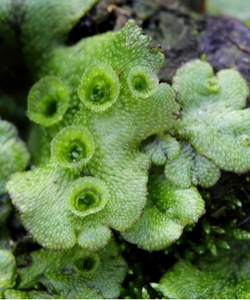
Marchantia
Marchantia thallus is a group of liverworts that belongs to the family of Marchantiaceae and the order of Marchantiales. Marchantia thallus is differentiated into two layers namely; the upper assimilatory or photosynthetic part and the lower storage part that bears an upper epidermis with barrel-shaped air channels. It bears tiny cup-like structures known as gemmae cups that are used for asexual reproduction. Vegetative reproduction takes place in both male and female thallus plants through these gemmae cups. Marchantia thrives mostly on silty soils, moist clay, shady places or recently burned land.
The female thallus bears 9 fingerlike projections while the male counterparts are disk-shaped in appearance with scalloped edges. Of the 65 Marchantia species, only 3 species are common and they include; Marchantia polymorpha, Marchantia palmate and Marchantia nepalensis. Marchantia is dioecious in nature thus both the male and female reproductive organs are borne in separate individuals. Sexual reproduction occurs by the joining of the male and female gametes.
Gupta et al., (2015) reported that Marchantia species are used in traditional Chinese medicine for protecting the liver and for treating hepatitis.

Reishi Mushroom
Reishi Mushroom is botanically known as Ganoderma lucidum and it belongs to the Ganodermataceae family. Reishi Mushroom is most prevalent in the Asian countries such as Japan, China, North and South Korea, Taiwan Indonesia and several other Asian countries. Reishi Mushroom is a broad, dark mushroom distinguished by its glossy exterior and woody texture. This suggests the origin of its name lucidum, which is derived from the Latin word “lucidus”. Lucidus simply connotes brilliant or shiny and this refers to the shiny surface of the Ganoderma mushroom.
Different parts of the Asian countries have different names for Ganoderma lucidum for example, the Japanese people refer to it as rōmaji, , the Chinese people call it língzhī, Ling Zhi, pinyin or while the Vietnamese refer to it as linh chi. Ganoderma is considered a miraculous plant thus the reason it is mostly used for medicinal purposes, especially in the Asian continent. Ganoderma lucidum produces a group of triterpenes known as ganoderic acids. Ganoderic acids possess a molecular structure that is related to steroid hormones.
Other sterols found in reishi mushroom are; lucidadiol, ganoderol, ganodermadiol, ganoderiol and ganodermanontriol. Ganoderma also contains adenosine, alkaloids, coumarin, organic germanium, mannitol and polysaccharides (e.g. beta-glucan). Ganoderma lucidum has a strong bitter taste thus it is traditionally prepared as a hot water extract.
Li and Wang (2006) showed that a ganoderic acid isolated from Ganoderma lucidum exhibited inhibitory effects on the replication of hepatitis B virus (HBV) in HepG2215 cells (HepG2- HBV-producing cell line) over 8 days. This suggests that Ganoderma is effective for treating hepatitis.
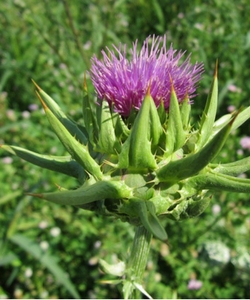
Milk thistle
Milk thistle is botanically known as Silybum marianum and belongs to the Asteraceae family. This plant is originally from Asia and Southern Europe before spreading to other parts of the world. Milk thistle is known by other names such as the Mediterranean milk thistle, Mary thistle, cardus marianus, variegated thistle, Saint Mary’s thistle, blessed milk thistle, Scotch thistle and Marian thistle. Milk thistle can be an annual or biennial plant and it can grow between 30 to 200 centimetres height. It is distinguished by its reddish-purple flowers with greenish oblong leaves that bear white veins. The hairless bracts bear spine-edged appendages and the flowers usually bloom between June and August.
Studies reveal that the milk thistle plant extract known as silymarin (Silybum marianum) has been effective for treating chronic liver diseases since time immemorial. Freedman et al., (2011) examined the effects of silymarin use on subsequent liver disease progression in 1049 patients of the Hepatitis C Antiviral Long-Term Treatment against Cirrhosis (HALT-C). The study showed that the silymarin use among patients with advanced hepatitis C-related liver disease is effective for preventing inflammation, fibrous thickening and degeneration of cells caused as a result of hepatitis.

Rhodiola kirilowii (Regel)
The genus Rhodiola contains more than 200 species of which one of them is Rhodiola kirilowii or regel. It is a medicinal plant that belongs to the Crassulaceae family. It is originally from Asia, the Alaska and Europe where both the rhizomes and roots are used mostly as an herbal tonic for tackling diseases. Rhodiola kirilowii contains anti-inflammatory (reduces inflammation), adaptogen (helps the body to adapt to stress) and antimicrobial (active against microbes) properties.
Researchers reveal that the key chemical substances found in regel rhizomes and roots extracts are epigallogatechin gallate, salidroside, arbutin, tyrosol, fructopyrano-(1-4)-glucopyranose, daucosterol, rhodiocyanoside A, sucrose, beta-sitosterol, and lotaustralin. Furthermore, Rhodiola kirilowii is an excellent source of polyphenols and salidroside. Khare et al., (2015) report that the crude ethanol extract from the rhizomes of regel herb is effective for treating Hepatitis C.

Sophora flavescens
Sophora flavescens is an evergreen deciduous plant that belongs to the family of Fabaceae. This shrub is most prevalent in the Oceanica, China, Russia, the Pacific islands, South Korea and Japan. Sophora flavescens root is referred to as Ku shen and it contains the oxymatrine, which is its main alkaloid extract. Sophora flavescens grows approximately 1.5 metres by 1 metre and thrives best in alkaline, acidic and neutral soils. Sophora contains antioxidant and anti-inflammatory properties thus used mostly for medicinal and therapeutic purposes. Sophora contains several chemical compounds such as prenylflavonoid, Sophoridine, isoflavonoid, alkaloids, Sophoraflavanone G and Trifolirhizin.
Wang et al., (2010) attested that Sophora flavescens herb is effective for preparing herbal medicines for treating viral hepatitis. Sophora flavescens and licorice (Glycyrrhiza glabra) can be combined together to offer better liver protection and anti-hepatocarcinogenic effects.
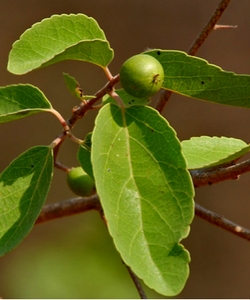
Governor’s Plum
Governor’s Plum is botanically known as Flacourtia indica and belongs to the family of Salicaceae. It is a flowering plant that is known by other names such as Indian plum, ramontchi, Madagascar plum, governor’s plum or batoko plum. Governor’s Plum is originally from Asia and Africa and it thrives well in the tropical and subtropical parts of the world. This fruit is distinguished by its spiny trunk and drooping branches that bear oval leaves. The fruit measures approximately 1 inch wide and it has similar taste and flavour to a plum.
The fleshy fruit bears 6 to 10 seeds in the layered carpels and the white-yellowish pulp is sweet with tangy acidic taste. Both the leaves, fruit and roots of the governor’s plum are used for preparing an herbal medicine. Governor’s Plum is an excellent source of calcium, dietary fibre, vitamin C, iron, potassium, phosphorus, protein, thiamine (vitamin B1), niacin (vitamin B3) and riboflavin (vitamin B2). According to Pandey (2014), the governor’s plum fruit can be used for preparing herbal medicines for treating liver diseases.
Books can be your best pre-collapse investment.
Carnivore’s Bible (is a wellknown meat processor providing custom meat processing services locally andacross the state of Montana and more. Whether your needs are for domestic meator wild game meat processing)
The Lost Book of Remedies PDF ( contains a series of medicinal andherbal recipes to make home made remedies from medicinal plants and herbs.Chromic diseases and maladies can be overcome by taking the remediesoutlined in this book. The writer claims that his grandfather was taughtherbalism and healing whilst in active service during world war twoand that he has treated many soldiers with his home made cures. )
Easy Cellar(Info about building and managing your root cellar, plus printable plans. The book on building and using root cellars – The Complete Root Cellar Book.)
The Lost Ways (Learn the long forgotten secrets that helped our forefathers survive famines,wars,economic crisis and anything else life threw at them)
LOST WAYS 2 ( Wordof the day: Prepare! And do it the old fashion way, like our fore-fathers did it and succeed longbefore us,because what lies ahead of us will require all the help we can get. Watch this video and learn the 3 skills that ensured our ancestors survival in hard times offamine and war.)





